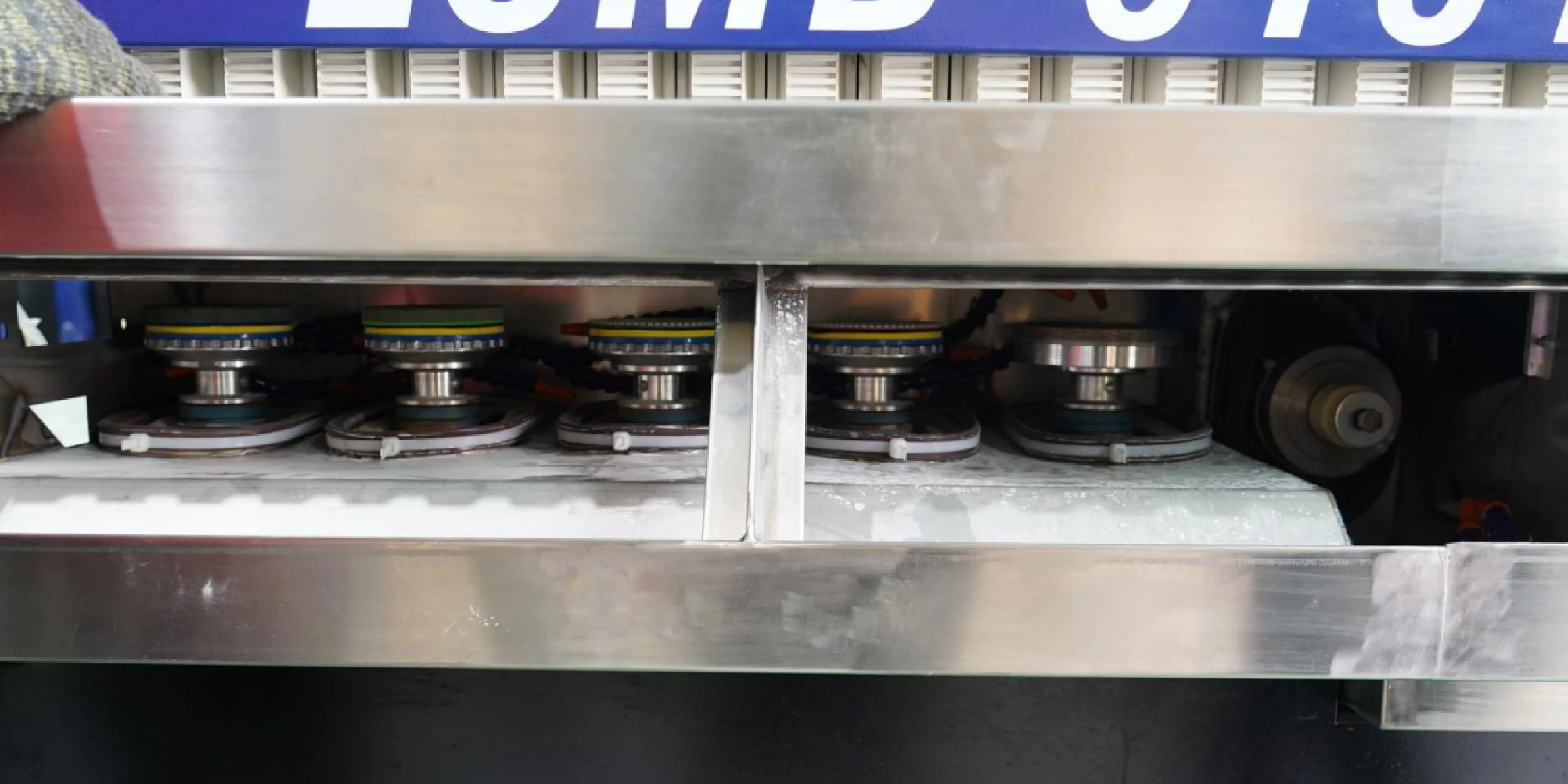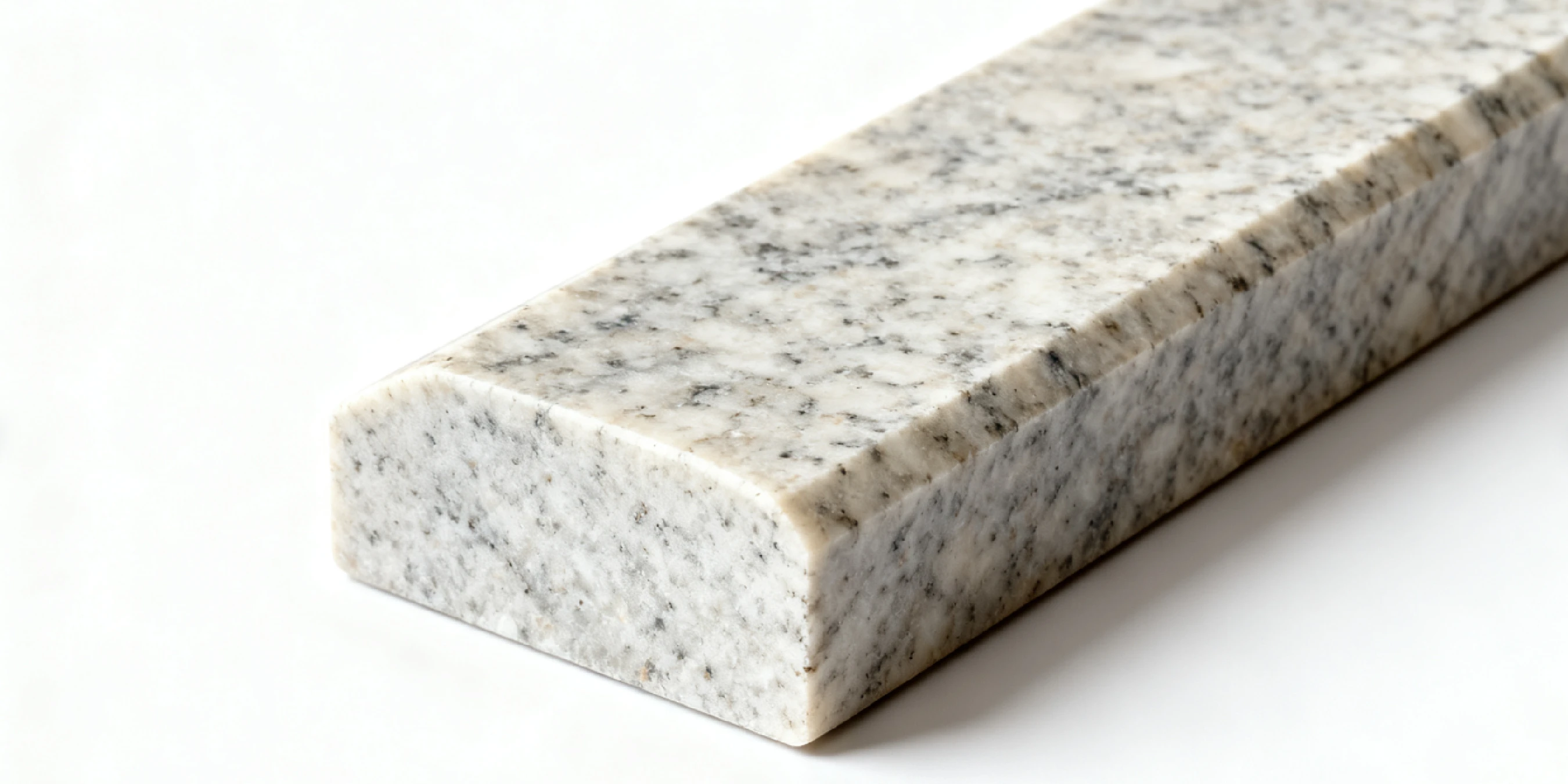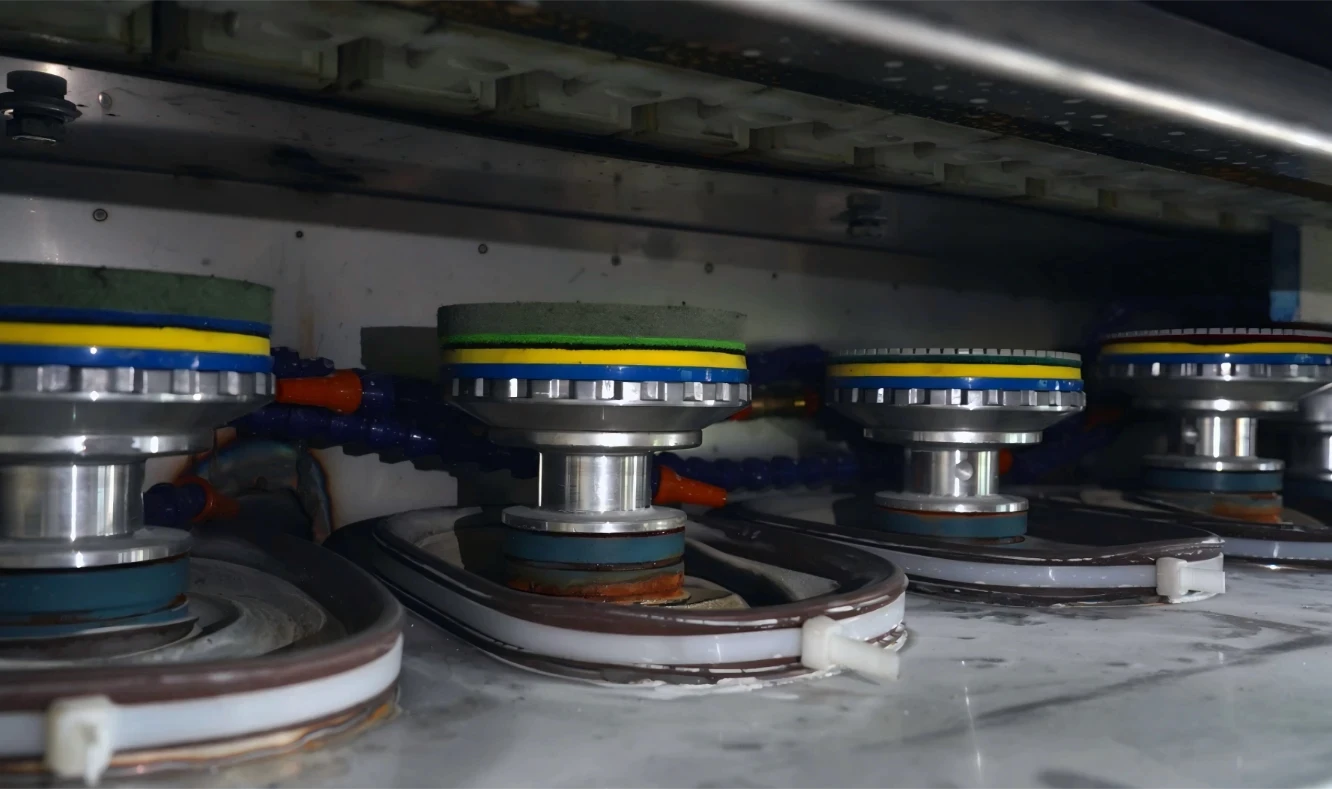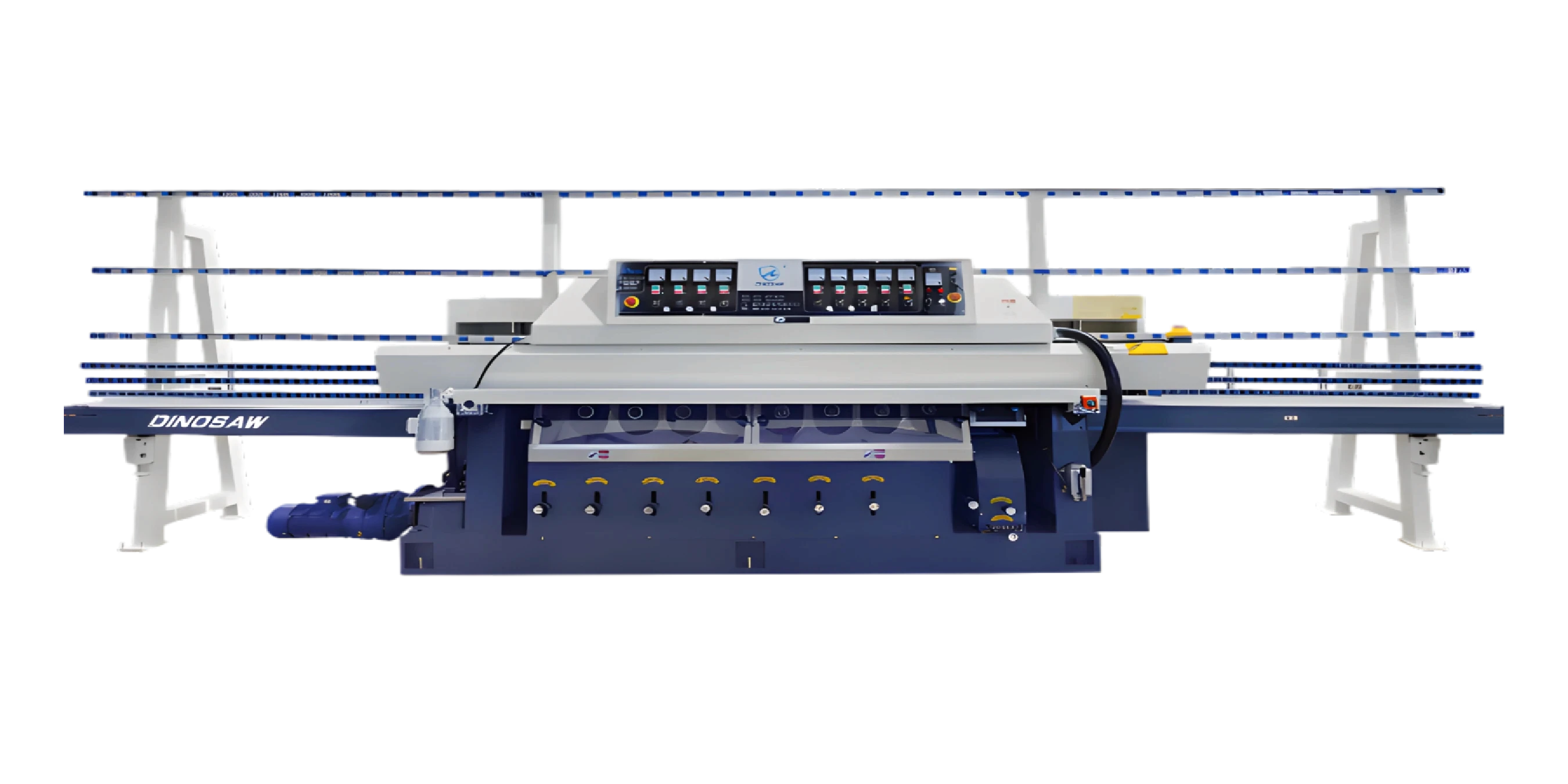Hi, this is Lizzy from Dinosaw ( Not a Robot ). Which Machine ( model ) do you want? Please WhatsApp us now
A technical guide to the glass edging machine. Explore system architecture, core components (wheels, spindles, controls), PLC vs. CNC differences, failure modes, and FAQs.
The DinoSaw Glass Edging Machine is an integrated system combining a rigid mechanical frame, precision spindles, and a dedicated control system to execute pre-programmed edge profiles on various glass types. Understanding this core architecture is the key to maximizing uptime, ensuring finish quality, and troubleshooting effectively.
This guide breaks down how each component contributes to the final polished edge, from the structural frame to the control logic.
System Architecture Overview
A glass edging machine operates as a cohesive system where mechanical stability and control precision work in tandem. The quality of a finished edge is not determined by the control system alone (PLC or CNC), but by the interplay of all major subsystems. The control system executes the program, but it is the tooling—the grinding and polishing wheels—and the process parameters that physically create the profile.
- Mechanical Frame: Provides the rigid foundation necessary to absorb vibrations and maintain alignment, crucial for high-precision grinding.
- Conveyor and Clamping System: Securely transports the glass sheet at a constant speed, ensuring consistent contact with the grinding wheels.
- Spindles and Grinding Heads: House the motors and grinding wheels, providing the power and stability for material removal and polishing.
- Coolant and Filtration System: Manages temperature, clears debris, and lubricates the contact point between the wheel and glass, preventing thermal shock and improving finish quality.
- Control System (PLC/CNC): The brain of the operation, executing programmed paths and managing process parameters like speed and pressure.

Core Components and Their Function
The performance of a DINOSAW Glass Edging Machine relies on the precise function of its core components.
Grinding and Polishing Wheels
The quantity and position of shaping and polishing wheels are configurable and vary by machine model and customer requirements. This allows the tooling layout to be optimized for specific part mixes and desired finish classes. For instance, the LSMB-314/80 model is equipped with 1 shaping wheel (150-180 mm diameter) and 3 polishing wheels (150-180 mm diameter). Wheels are sequenced from coarse to fine to progressively shape and finish the edge. Diamond wheels are used for rough grinding and shaping, while resin-bond and felt wheels are used for fine polishing. The pneumatic fixation system ensures stable and consistent pressure for a uniform finish. (Manufacturer-reported)
Spindles and Motors
Each spindle houses a high-power motor responsible for rotating a grinding or polishing wheel at optimal speed. While individual motor power is typically in the 1.5–3.0 kW per spindle range, the machine total power for a model like the LSMB-314/80 is 45 kW . Stability is critical to prevent vibration that could cause chipping or other surface imperfections.
Control System: PLC vs. CNC
The choice of control system depends on workflow needs. Both can produce complex profiles.
- PLC (Programmable Logic Controller): Ideal for repetitive, high-volume tasks like straight line glass edging. It excels in executing fixed programs reliably but offers less on-the-fly flexibility.
- CNC (Computer Numerical Control): Offers superior flexibility for high-mix production and intricate shape edging. Program handling is more dynamic, allowing for faster changeovers and finer parameter adjustments.
Conveyor and Clamping System
The conveyor uses high-grip timing belts to move the glass sheet smoothly at a variable speed of 1500–4000 mm/min. The clamping mechanism, featuring manually adjustable pressure wheels, secures the glass of varying thicknesses (working thickness up to 120 mm) to prevent any movement during processing, ensuring dimensional accuracy.

Common Failure Modes and Troubleshooting
Understanding potential issues is key to maintenance.
- Symptom: Edge chipping or cracking.
- Possible Causes: Incorrect wheel sequence, excessive grinding pressure, inadequate coolant flow, or worn-out diamond wheels.
- Mitigation: Verify wheel setup, adjust pressure settings, check coolant nozzles for blockages, and inspect wheels for wear.
- Symptom: Poor polish or hazy finish.
- Possible Causes: Contaminated coolant, worn polishing wheels, incorrect spindle speed.
- Mitigation: Replace coolant and clean the filtration system. Inspect and dress or replace polishing wheels. Verify motor RPMs are within spec.
Starting Settings for Typical Jobs
While optimal parameters vary, here are common starting points:
- 6mm Float Glass, Flat Polish: Conveyor speed: start around 2.0–3.0 m/min; apply moderate grinding pressure; ensure a continuous, clear coolant stream fully wetting the contact area (within the machine's 1500–4000 mm/min belt speed window).
- 10mm Tempered Glass, Arris: Conveyor speed: start around 1.0–2.0 m/min; use slightly higher pressure than flat polish; coolant flow should be steady with no aeration (within the machine's 1500–4000 mm/min belt speed window).
- 12mm Laminated Glass, Bevel: Conveyor speed: start around 0.8–1.5 m/min; lower pressure to avoid delamination; maintain generous coolant coverage (within the machine's 1500–4000 mm/min belt speed window).
Risks and Compatibility
Ensure your facility has a stable electrical supply matching the machine's requirements. A closed-loop coolant system is mandatory to handle the high water consumption (such as 1000 L/min) and prevent thermal shock. For data integration, our CNC systems are compatible with standard industry protocols, but confirm specific interface needs (e.g., OPC UA, Profinet) with our technical team. Incompatibility with coolant types can lead to premature wheel wear; use only recommended synthetic coolants.
Summary
A glass edging machine's performance is a function of its entire architecture, not just the control system. While both PLC and CNC controls can execute complex profiles, the final edge quality is ultimately determined by the mechanical stability of the frame, the precision of the spindles, and the correct configuration of tooling and process parameters. Understanding how these components interact is the foundation of operational excellence and effective maintenance.

FAQs - Technical Specifications and Operation
What is the difference between a glass edging machine and a glass polishing machine?
A glass edging machine is a comprehensive system that performs the entire process, from coarse grinding to shaping and fine polishing. A glass edge polishing machine can refer to the entire system or specifically to the final stages that use polishing wheels (e.g., cerium or felt) to achieve a high-gloss finish. Our machines integrate both functions in one automated sequence.
How does the control system impact operation if both PLC and CNC can make complex shapes?
The key difference is workflow flexibility. A CNC controller simplifies the programming and management of multiple different jobs, making it ideal for high-mix environments. A PLC is more cost-effective for dedicated, high-volume production of a few standard profiles. The choice is about operational efficiency, not geometric capability.
What are the power and footprint requirements?
The machine total power is 45 kW . The footprint for a model like the LSMB314/80 is approx. 7500×1200×2200 mm, with a weight of ~4 t. Always verify the exact datasheet for your chosen model, which can be found in our guide to choosing the right edging machine model.
What software is used for programming the CNC?
Our CNC machines use an industry-standard G-code compatible interface, which can import DXF files from common CAD software. This allows for seamless transfer of designs from the engineering department to the factory floor. Basic training on the interface is included with installation.
How often do grinding wheels need to be replaced?
Wheel lifespan depends on usage, glass type, and maintenance. Diamond grinding wheels can last for [TBD] thousands of meters, while polishing wheels have a shorter lifespan. Regular inspection for wear and adherence to the recommended preventative maintenance schedule is the best way to maximize wheel life.
Why is coolant management so important for glass fabrication equipment?
Proper coolant management is critical for three reasons: it prevents thermal shock that can crack the glass, it lubricates the grinding process to achieve a smoother finish, and it flushes away glass particles that would otherwise clog the wheels and reduce their effectiveness. A well-maintained filtration system is essential for any glass fabrication equipment.
























 English
English 中文
中文 Italian
Italian Türkçe
Türkçe Português
Português

